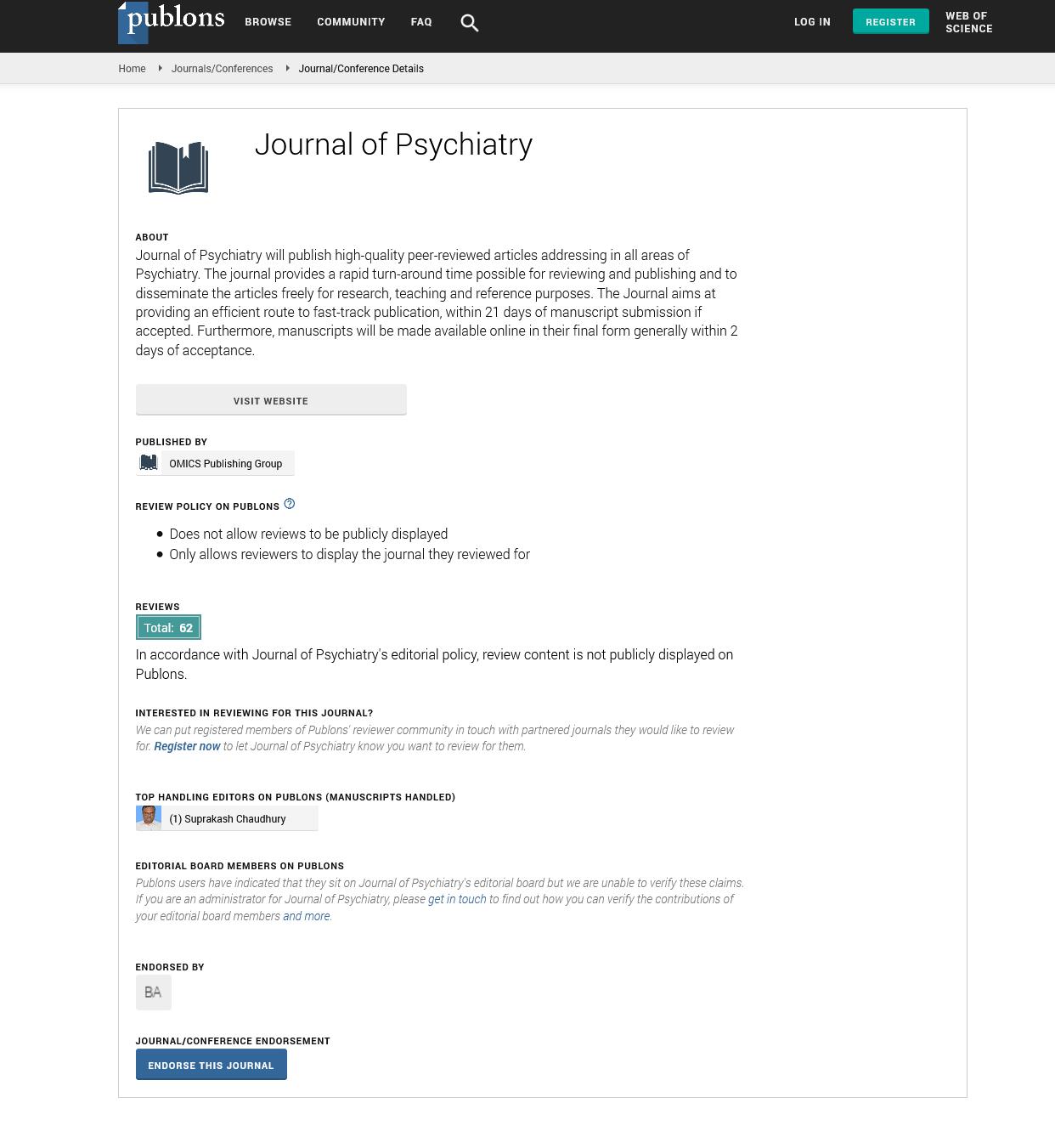Indexed In
- RefSeek
- Hamdard University
- EBSCO A-Z
- OCLC- WorldCat
- SWB online catalog
- Publons
- International committee of medical journals editors (ICMJE)
- Geneva Foundation for Medical Education and Research
Useful Links
Share This Page
Open Access Journals
- Agri and Aquaculture
- Biochemistry
- Bioinformatics & Systems Biology
- Business & Management
- Chemistry
- Clinical Sciences
- Engineering
- Food & Nutrition
- General Science
- Genetics & Molecular Biology
- Immunology & Microbiology
- Medical Sciences
- Neuroscience & Psychology
- Nursing & Health Care
- Pharmaceutical Sciences
Perspective - (2025) Volume 28, Issue 2
Mirror Minds: Exploring Neural Synchrony in Autism Spectrum Disorders through Hyperscanning
Olivia Brown*Received: 24-Feb-2025, Manuscript No. JOP-25-28818; Editor assigned: 26-Feb-2025, Pre QC No. JOP-25-28818; Reviewed: 12-Mar-2025, QC No. JOP-25-28818; Revised: 18-Mar-2025, Manuscript No. JOP-25-28818; Published: 02-Mar-2025, DOI: 10.35248/2167-0358.25.28.737
Description
Autism Spectrum Disorders (ASD) are a group of conditions characterized by difficulties in social interaction, communication and a tendency to engage in repetitive behaviors. People with ASD can experience these challenges in varying degrees, making the condition highly individualistic. Despite these variations, a key feature shared across many individuals with ASD is difficulty in forming social connections. Traditional research has largely focused on understanding the individual brain differences that may contribute to these challenges. However, more recent approaches are expanding our view by looking at how individuals with ASD interact with others in real time. One method gaining attention in this area is hyperscanning. Hyperscanning involves simultaneous brain imaging of two or more people as they interact with each other. This technique allows researchers to study how brains synchronize during social exchanges, providing insight into the neural mechanisms behind social behavior. By examining the brain activity of both individuals at once, hyperscanning can reveal how people’s neural processes align or fail to align during communication and interaction. This method has proven useful for understanding how individuals with ASD experience and respond to social cues compared to neurotypical individuals.
The concept of neural synchrony refers to the way in which different areas of the brain communicate and coordinate with one another during social interaction. In typical social exchanges, the brain areas involved in processing emotions, facial expressions and gestures tend to work in concert. However, individuals with ASD may experience disruptions in this synchrony, making it more challenging for them to interpret social cues, engage in reciprocal conversations and form emotional connections. Through hyperscanning, researchers can study these disruptions and gain a deeper understanding of the neural processes that contribute to the social difficulties seen in ASD. In one study using hyperscanning, researchers observed the brain activity of both children with ASD and typically developing children while they engaged in simple social tasks.
The researchers found that the children with ASD showed less synchronized brain activity with their peers compared to the typically developing children. This lack of synchrony could help explain the difficulties that individuals with ASD experience in establishing social bonds, as the brain's inability to properly synchronize with others may impair the ability to respond to social signals in real time.
Another important area of research using hyperscanning in ASD is understanding the role of mirror neurons. Mirror neurons are a type of brain cell that activates both when an individual performs an action and when they observe someone else performing the same action. These neurons are thought to play a role in empathy, imitation and social learning. In individuals with ASD, it has been suggested that mirror neuron activity may be impaired, leading to challenges in understanding others' emotions and intentions. By using hyperscanning to examine the brain activity of individuals with ASD in social contexts, researchers can explore whether there are differences in the functioning of these mirror neurons during interactions.
This approach has the potential to inform new therapies or interventions for individuals with ASD. If specific neural pathways involved in social interaction and empathy are identified, interventions could be developed to strengthen these pathways. For instance, targeted social skills training or therapies designed to enhance neural synchrony could improve social functioning in individuals with ASD. Hyperscanning research could also guide the development of more effective treatments by pinpointing which aspects of the brain’s activity need to be addressed. As we continue to explore the neural basis of social behavior in ASD, hyperscanning holds great potential for advancing our understanding of the condition. By observing how brains synchronize during social interactions, researchers can begin to identify the subtle neural processes that affect social engagement and communication in individuals with ASD. This research not only opens new doors for diagnosis and treatment but also brings us closer to understanding the complex and individualistic nature of ASD itself.
Citation: Brown O (2025). Mirror Minds: Exploring Neural Synchrony in Autism Spectrum Disorders through Hyperscanning. J Psychiatry.28:737.
Copyright: © 2025 Brown O. This is an open-access article distributed under the terms of the Creative Commons Attribution License, which permits unrestricted use, distribution and reproduction in any medium, provided the original author and source are credited.

